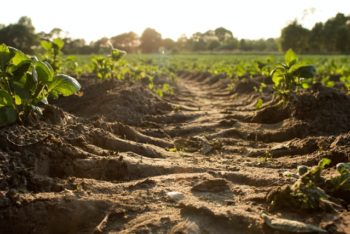News – Blog
Why do we need the Homegrown Innovation Challenge?
8 February 2022
Sowing the seeds of change requires an environment that is ripe for change. Especially if the agricultural practices used are grim reaping.
For years, Canada and many other high-income countries have heavily relied on fresh produce imports and stable sunnier climates in order to eat fresh vegetables and fruits year round, at an affordable price. More than 80% of the Canadian fresh fruit market is supplied through imports.
Many of the countries that supply fresh produce imports have already begun experiencing extreme weather events and water stresses, exacerbated by climate change and overstretched resources. While current agricultural practices are contributing to climate change, agriculture itself is suffering because of climate change. At this current rate, disruptions in the supply chain are likely to continue and worsen in the future, signifying the need for homegrown innovations to grow fresh produce.
That’s why the Homegrown Innovation Challenge is being run: to support new solutions that reduce Canada’s reliance on imported fresh produce, build the resilience of food systems and help Canada deal with future uncertainty – starting with creating new technologies that let crops grow out of season. Solving that challenge needs breakthroughs in developing growing mediums and ensuring the plants have the exact nutrients and water they require, no matter the weather.
The importance of soil preservation
Future-proofing food production is becoming more essential and the solutions needed are likely very broad. With a large majority of arable land being degraded by desertification, pesticides, flooding, deforestation and urbanisation, our global soil health is suffering and it is difficult to open up new fertile farmland without destroying natural biodiversity. This means growing food for our growing populations is of major concern. Soil is considered a non-renewable resource, which means its loss is not recoverable during a human lifespan; it can take 500 years or more for an inch of topsoil to form.
The rate at which topsoil is lost varies among geographies. Although stark headlines have repeated that the world has only 100, 60 or even 30 years of harvests left, there is no scientific basis to them. Yet, while the claims are overblown, soil erosion is an important problem because it is the main ingredient in how and where we reliably grow food. In the process of competing in the Homegrown Innovation Challenge, teams will have to grapple with the challenge of growth media. One of the outcomes of this could be the development of different soil mediums that we can use to replace topsoil after flooding or in snowy conditions. Alternatively, this Challenge may open up the development of other “soilless cultivation” approaches – solid or liquid, with organic or inorganic substrates.

Innovation is needed in all areas
Water availability and quality are other important ingredients. Current agricultural approaches contribute to water pollution and acidification of oceans caused by fertilizer runoff. This is known to impact rivers and lakes as it causes algal blooms that devastate ecosystems. The Economist’s Food Sustainability Index shows that Canada has one of the most sustainable water practices compared to many other countries where fruit and vegetable imports are sourced. This makes Canada an ideal testbed for developing and testing solutions to mitigate the water impact of agricultural practices. The Homegrown Innovation Challenge may result in the scale-up of more sustainable use of water in agriculture. Water stresses could also soon be averted with the scaled use of aquaponics, smart irrigation systems, moisture levels measurement and many more ripening innovations in irrigation practices.
Furthermore, there is an increasing expectation by consumers that our fruits and vegetables are grown using agricultural practices that limit or avoid the use and spread of pesticides and toxic fertilizers. Booming innovation in areas such as aeroponics – which cultivates plants without soil by suspending them in an oxygen-rich environment and misting their roots with a nutrient solution – are helping address these concerns by farming in closed systems, meaning that any pesticides or fertilizers used rarely enter the natural system without prior treatment.
Why change is needed now
It is certain that our current agricultural practices globally need to change. These practices are both unsustainable for our environment (agriculture accounts for about 25% of greenhouse gas emissions) and fail to feed the approximately 30% of the world’s population who lacked access to adequate food in 2020 and into 2021. But there’s a positive story too: major leaps in agricultural innovation can have an incredibly positive impact both fighting climate change and feeding more people as the world’s population grows to 10 billion by 2050.
Practically, however, figuring out all these pieces, from sowing seeds to harvesting out of season, requires a partnership of people with diverse expertise to think creatively about what needs changing in the environment to allow that seed to grow. The Homegrown Innovation Challenge aims to help fill this gap – driving technological innovation, but also bringing together the right partners and networks.
What will result is a more resilient future food system, filled with more solutions to how we grow food that can be scaled to different agricultural settings globally.
The Homegrown Innovation Challenge launched today – please visit the website for more information. The application deadline for (optional) Spark Awards is 3 May 2022, and the deadline for the first phase of the Challenge is 20 December 2022.
